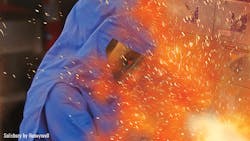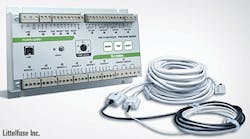Although it wasn’t until the 1800s that Thomas Edison and others figured out how to harness electrical energy, humans have been dabbling in electricity since at least 600 B.C. The concept of the electric-arc flash, however, is a relatively new phenomenon.
Ralph Lee, a retired DuPont electrical engineer, first drew attention to the hazard of arc flashes in his technical paper, “The Other Electrical Hazard: Electric Arc-Blast Burns,” which he presented at the 1981 Industrial Applications Society Annual Meeting. Before Lee’s seminal paper, electrical safety focused primarily on the risk of electrical shock. But Lee argued that the electric-arc flash posed just as great a risk.
“There is another hazard [that] few appreciate – the case where contact is not necessary to incur injury,” Lee wrote. “This is the radiation burn from the fierce fire of electrical arcs, due to a short circuit that develops from poor electrical contact or failure of insulation.”
In simple terms, an arc flash is the fireball caused by a short circuit in high-voltage electrical equipment. The fireball releases dangerous levels of thermal and mechanical energy. Given how Lee described the dire consequences of being anywhere near an electric-arc blast, it’s a bit shocking that it took over a decade for his concepts to gain mainstream acceptance.
“Next to the laser, the electric arc between metals is the hottest thing on earth, or about four times as hot as the sun’s surface,” wrote Lee, adding that burns from arc flashes “can be fatal when the victim is even several feet from the arc.”
Heat exceeding 35,000 F isn’t the only thing that can make an arc-flash accident truly macabre. A 50-kilo-amp arc fault, according to one estimate, can produce a pressure blast of 3,600 pounds per square feet, which can thrust victims into nearby equipment and hurl shrapnel and molten metal at speeds of over 700 miles per hour. It also can generate sound pressure approaching 165 dB, which is louder than gunfire or an airplane taking off.
Hearing damage, third-degree burns, blindness and nerve damage are among the ways that an arc-flash accident can forever change a worker’s life – if he or she is lucky enough to survive. Because of their violent nature, arc-flash accidents exact a steep financial toll as well; the cost of downtime, equipment replacement, medical care and litigation can run into the millions of dollars.
According to the National Fire Protection Association and the Institute of Electrical and Electronics Engineers, between five and 10 arc-flash incidents occur every day on the job in the United States. Although arc-flash explosions and other electrical incidents comprise just a small sliver of the overall number of work-related incidents, NFPA and IEEE point out that “they are disproportionately fatal and, in the case of burns, may result in extended hospitalization and rehabilitation.”
NFPA and IEEE, which publish the go-to standards for arc-flash safety in the workplace (NFPA 70E and IEEE 1584, respectively), acknowledge that “several areas of arc-flash phenomena need further testing and validation.” The organizations have formed a joint research group to study, among other things: the intensity of an arc fault’s sound-pressure wave; the toxicity of the plasma and gases generated by an electrical arc; the medical effects of “various wavelengths of energy in arcing faults”; and the effectiveness of arc-resistant PPE.
Protecting Workers
Despite all that we don’t know, industry’s awareness and understanding of the arc-flash hazard has come a long way since the early 1980s. In a recent survey conducted by Littelfuse Inc., a Chicago-based manufacturer of circuit-protection products, 85 percent of the 825 respondents indicated that they believe it’s important to take steps to mitigate the risk of arc-flash accidents. A majority of the respondents (who included safety professionals, plant managers and engineers) indicated that they have completed flash-hazard assessments in their respective facilities.
Tony Locker, PE, manager of product management for Littelfuse, attributes the increased awareness to the evolution of the major electrical-safety standards. Since 2002, the National Electrical Code (NFPA 70) has required most electrical equipment to be marked with arc-flash warning labels, while the 2000 edition of NFPA 70E introduced its arc-flash hazard-risk categories for PPE selection. Both NFPA 70E and IEEE 1584 include equations for estimating the prospective energy that would be released during an arc flash, which help determine PPE selection and approach limits and clearances.
Still, the most effective way to eliminate the risk of an arc flash – or electrical shock, for that matter – is to turn off the power before working on equipment. OSHA 1910.333 requires live parts to be de-energized before employees work on or near them. However, the standard allows employers to sidestep the requirement if they “can demonstrate that de-energizing introduces additional or increased hazards or is infeasible due to equipment design or operational limitations.”
Facilities that must perform work on live equipment are “very much concerned” about the threat of arc-flash accidents, Locker says. It’s a very real threat in oil and gas facilities and other process operations, but he adds that it’s an issue for any manufacturing environment that has corrosive, dusty or wet conditions (which can erode wiring insulation), or vibration-producing equipment located close to electrical switchgear.
“Or if you have someone working inside electrical switchgear, and they drop a screwdriver and it goes between live wires, then the current wants to travel from one live wire through the screwdriver to the other one,” Locker explains. “The screwdriver can’t handle that amount of current, so essentially it explodes.”
When it’s necessary to work on an energized circuit, employers need to perform a flash-hazard analysis to determine the flash-protection boundaries and the potential energy of the arc-flash hazard. In addition to PPE and insulated tools, protective practices include the use of barriers and blankets, arc-resistant equipment, high-resistance grounding resistors, arc-flash relays and other methods for limiting arc energy.
Based on customer demand, the current-limiting fuse traditionally has been the most popular technology for mitigating arc flash, according to Locker. However, he notes that the arc-flash relay – a system that detects developing arc-flash incidents by looking for excess light and current – has seen rapid adoption in recent years. An arc-flash relay, Locker explains, can lower the incident energy of an arc flash, thereby lowering the hazard-risk category by one or two notches (HRC 4 is the most dangerous category, while HRC 1 is the least dangerous).
Here’s how it works: If the sensors in an arc-flash relay detect too much light and then too much current, the system trips the main circuit breaker. “It can do that in 1 millisecond,” Locker says.
Full disclosure: Littelfuse makes arc-flash relays, among other electrical-safety products. But Locker asserts that a roughly $5,000 investment in any company’s arc-flash relay “is by far the most bang for your buck and the most easily retrofittable solution you could do.” He also emphasizes that when it comes to the arc-flash hazard, “there’s no silver bullet that will solve everything.”
“You essentially have a bomb, if you will, inside these metal [electrical] enclosures,” Locker says.

